
Fish-Flavored Eggplant is a creative and nutritious dish that combines the flavors of fish and eggplant. Not only is it delicious, but it also boasts high nutritional value. This dish primarily features eggplant as the main ingredient, cooked using unique techniques and seasoning methods to bring out the rich fish flavor. Eggplant in Fish-Flavored Eggplant is rich in vitamins and dietary fiber, promoting gastrointestinal movement and aiding in preventing constipation, contributing to overall health. The fish flavoring provides protein and minerals, offering energy and essential nutrients to the body. This dish is suitable for all kinds of occasions, whether it’s a family gathering or a friends’ get-together, making it a must-try culinary delight.
Ingredients for Fish-Flavored Eggplant:
| Eggplant | 200g |
| Pork | 100g |
| Garlic | 6g |
| Green onion | 6g |
| Egg | 100g |
| Flour | 50g |
| Salt | 2g |
| Essence of chicken | 1g |
| Sugar | 5g |
| Dark soy sauce | 2g |
| Mature vinegar | 5g |
| Edible oil | 10g |
| Baking powder | 3g |
| Bean paste | 5g |
| Pepper powder | 1g |
| Corn starch | 53g |
Step:
1.First, let’s prepare the ingredients. Take one purple eggplant and place it in a bowl. Hold the knife at a 45-degree angle on the cutting board. Make an incision from the top to the bottom of the eggplant, making sure not to cut all the way through. Flip the eggplant over and make another incision perpendicular to the first, also without cutting all the way through. Repeat this process until the eggplant is uniformly sliced but still connected, as shown in the picture.
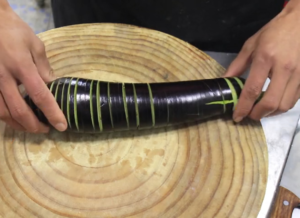 2.Take a small piece of pork, preferably a cut with a good balance of fat and lean meat for a richer texture. Start by slicing the pork into thin, even slices, aiming for a thin consistency in subsequent mincing. Then, use the back of the knife to mince the pork slices into finely chopped meat, being careful not to over-mince and maintaining some texture in the meat. This will allow the minced meat to hold its shape during cooking.
2.Take a small piece of pork, preferably a cut with a good balance of fat and lean meat for a richer texture. Start by slicing the pork into thin, even slices, aiming for a thin consistency in subsequent mincing. Then, use the back of the knife to mince the pork slices into finely chopped meat, being careful not to over-mince and maintaining some texture in the meat. This will allow the minced meat to hold its shape during cooking.
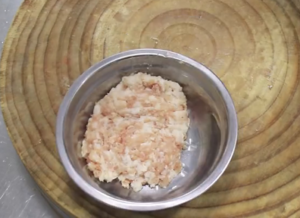 3.Take a few cloves of garlic and gently crush them to make peeling easier. Then, finely chop the garlic into small pieces. Cut a segment of the white part of a large spring onion, wash it thoroughly, and lightly score it with the back of the knife to create cross-shaped marks. This will help to finely chop the spring onion into smaller pieces. Combine the chopped garlic and spring onion together for later use. These ingredients contribute fresh flavors and textures, adding layers of taste to the dish.
3.Take a few cloves of garlic and gently crush them to make peeling easier. Then, finely chop the garlic into small pieces. Cut a segment of the white part of a large spring onion, wash it thoroughly, and lightly score it with the back of the knife to create cross-shaped marks. This will help to finely chop the spring onion into smaller pieces. Combine the chopped garlic and spring onion together for later use. These ingredients contribute fresh flavors and textures, adding layers of taste to the dish.
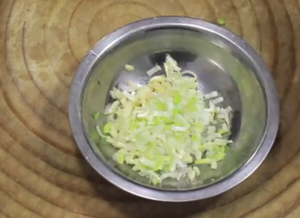 4.Prepare a large bowl. Crack two eggs into the bowl, add a handful of flour and a handful of cornstarch in a 1:1 ratio. Pour in 10 grams of edible oil and add some water. Stir the mixture in one direction to form a batter. Add a small amount of baking powder and mix well. The baking powder helps to make the coating fluffy. Place the sliced eggplant into the batter, ensuring that both the surface and the cut sides are evenly coated.
4.Prepare a large bowl. Crack two eggs into the bowl, add a handful of flour and a handful of cornstarch in a 1:1 ratio. Pour in 10 grams of edible oil and add some water. Stir the mixture in one direction to form a batter. Add a small amount of baking powder and mix well. The baking powder helps to make the coating fluffy. Place the sliced eggplant into the batter, ensuring that both the surface and the cut sides are evenly coated.
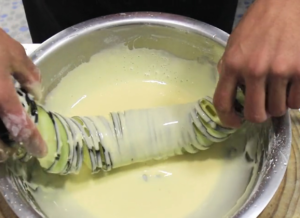 5.Now, let’s start frying the eggplant. Heat oil in a pan until it reaches about 50% of its maximum temperature. Gently place the eggplant slices into the pan, taking care not to break them apart. Cook on low heat for approximately 3 minutes. During this time, use chopsticks to separate any densely packed slices to ensure even cooking. After 3 minutes, when the surface of the eggplant turns golden brown, remove them from the oil and drain off excess oil before plating.
5.Now, let’s start frying the eggplant. Heat oil in a pan until it reaches about 50% of its maximum temperature. Gently place the eggplant slices into the pan, taking care not to break them apart. Cook on low heat for approximately 3 minutes. During this time, use chopsticks to separate any densely packed slices to ensure even cooking. After 3 minutes, when the surface of the eggplant turns golden brown, remove them from the oil and drain off excess oil before plating.
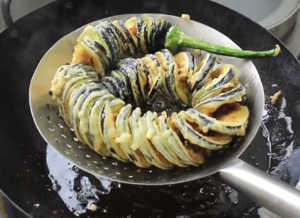 6.Heat an appropriate amount of oil in a wok. Once hot, add the minced pork and quickly stir-fry to evenly cook. Use a spoon to break up the minced pork, ensuring it is heated evenly. When the pork turns white in color, add 5 grams of bean paste and continue stirring to mix well. Next, add the chopped spring onion and garlic, stir-frying to combine the flavors. Drizzle a small amount of water along the edge of the wok to increase moisture and prevent burning. It’s time to season the dish. Add 2 grams of salt for some savory taste, 1 gram of essence of chicken and 1 gram of pepper powder for freshness and a hint of spiciness, 5 grams of sugar for sweetness to balance the spiciness, 2 grams of dark soy sauce to enhance the color, and 5 grams of mature vinegar for acidity and added depth of flavor. Continue stirring to fully incorporate the seasonings with the minced pork. Finally, add a small amount of water starch, turn up the heat to thicken the sauce, and prevent it from becoming too watery. Stir continuously to avoid sticking. Once the sauce has thickened, turn off the heat.
6.Heat an appropriate amount of oil in a wok. Once hot, add the minced pork and quickly stir-fry to evenly cook. Use a spoon to break up the minced pork, ensuring it is heated evenly. When the pork turns white in color, add 5 grams of bean paste and continue stirring to mix well. Next, add the chopped spring onion and garlic, stir-frying to combine the flavors. Drizzle a small amount of water along the edge of the wok to increase moisture and prevent burning. It’s time to season the dish. Add 2 grams of salt for some savory taste, 1 gram of essence of chicken and 1 gram of pepper powder for freshness and a hint of spiciness, 5 grams of sugar for sweetness to balance the spiciness, 2 grams of dark soy sauce to enhance the color, and 5 grams of mature vinegar for acidity and added depth of flavor. Continue stirring to fully incorporate the seasonings with the minced pork. Finally, add a small amount of water starch, turn up the heat to thicken the sauce, and prevent it from becoming too watery. Stir continuously to avoid sticking. Once the sauce has thickened, turn off the heat.
 7.Next, evenly pour the prepared sauce over the eggplant, allowing the eggplant to absorb the delicious flavors. After careful selection, cutting, and cooking, the delicious Fish-Flavored Eggplant is now complete. It boasts a rich fish flavor and a delicate texture that will surely whet your appetite. Every bite offers a perfect fusion of eggplant and fish-flavored sauce, creating an irresistible delight.
7.Next, evenly pour the prepared sauce over the eggplant, allowing the eggplant to absorb the delicious flavors. After careful selection, cutting, and cooking, the delicious Fish-Flavored Eggplant is now complete. It boasts a rich fish flavor and a delicate texture that will surely whet your appetite. Every bite offers a perfect fusion of eggplant and fish-flavored sauce, creating an irresistible delight.
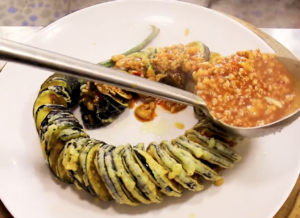
Tips:
1.Choose long purple eggplants for their visually appealing color. Additionally, select tender pork for a richer texture.
2.Cut the eggplant into continuous pieces to allow the fish-flavored sauce to penetrate it better, resulting in a flavorful dish. Chop the pork into minced meat, being careful not to make it too fine, so that there is still some texture and the meat holds its shape during cooking.
3.If you’re not confident in your knife skills, you can place two chopsticks on both sides of the eggplant as you cut. This way, the knife will stop when it touches the chopsticks, preventing it from cutting all the way through.
Fish-Flavored Eggplant is a traditional dish with rich local flavors. It primarily uses eggplant as the main ingredient, cooked with unique fish-flavored seasonings to create a delicious and nutritious dish. The preparation of this dish requires skilled cooking techniques and unique seasoning methods. Each step needs to be carefully mastered and executed. During the cooking process, the eggplant undergoes multiple steps such as boiling, frying, and stir-frying to bring out the rich fish-flavored taste. Fish-Flavored Eggplant is not only a delicacy but also represents the preservation and display of Chinese food culture. It carries the culinary traditions and wisdom of the Chinese people, allowing people to experience the charm of Chinese traditional culture while enjoying the flavorsome cuisine.

